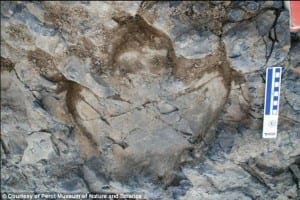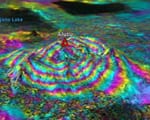Some of the footprints are so detailed that they reveal the creatures’ skin texture, and tracks of bugs and worms are visible.
One of the U.K.’s widely circulated newspapers, the Daily Mail, has covered the research of paleontologist Anthony Fiorillo, an adjunct associate professor in SMU’s Roy M. Huffington Department of Earth Sciences.
Fiorillo is curator of earth sciences at the Perot Museum of science and natural history. He has collected fossils throughout North America and parts of Asia, but has primarily worked in western Texas and Alaska.
Daily Mail reporter Sarah Griffiths reported the news about the discovery of a dinosaur track site in Alaska’s Denali National Park, which shows that herds of duck-billed dinosaurs thrived there. “Now that’s a Jurassic Park!.”
EXCERPT:
By Sarah Griffiths
Daily Mail
An incredible dinosaur track site with perfectly preserved footprints has been discovered in Denali National Park, Alaska.The footprints belong to herds of duck-billed dinosaurs called hadrosaurs, which thrived in the ancient high-latitude, polar ecosystem in the Late Cretaceous period between 100 and 66 million years ago.
They roamed the area in large family groups, travelling across the rugged terrain together.
Some of the footprints are so detailed that they reveal the creatures’ skin texture.
Even tracks of bugs and worms can be seen.The footprints were found by three palaeontologists in 2007, when the Upper Cretaceous Cantwell Formation in the Alaska Range of Denali had not been explored.
On the last day, perched precariously on the steep side of the mountain, Anthony Fiorello, of Perot Museum, Dallas, Texas and paleontologists from the University of Kansas and Hokkaido University Museum, were ‘giddy – somewhere between giggling and crying’ when they came across the wealth of tracks.
‘Without question, Denali is one of the best dinosaur footprint localities in the world, but what we found that last day was incredible – so many tracks, so big, and so well preserved,’ said Dr. Fiorillo.
‘Many had skin impressions so we could even see what the bottom of their feet looked like. And there were lots of invertebrate traces – the tracks of bugs, worms, larvae and more – which were important to us because they showed an ecosystem existed during the warm parts of the years.’
The paper, published in the journal Geology, provides an insight into the heard structure of hadrosaurs, which lived as families within the warmer-than-expected Arctic climate.
Follow SMUResearch.com on Twitter.
For more information, www.smuresearch.com.
SMU is a nationally ranked private university in Dallas founded 100 years ago. Today, SMU enrolls nearly 11,000 students who benefit from the academic opportunities and international reach of seven degree-granting schools. For more information see www.smu.edu.
SMU has an uplink facility located on campus for live TV, radio, or online interviews. To speak with an SMU expert or book an SMU guest in the studio, call SMU News & Communications at 214-768-7650.



 Low IQ students learn to read at 1st-grade level after persistent, intensive instruction
Low IQ students learn to read at 1st-grade level after persistent, intensive instruction Richest marine reptile fossil bed along Africa’s South Atlantic coast is dated at 71.5 mya
Richest marine reptile fossil bed along Africa’s South Atlantic coast is dated at 71.5 mya Satellite view of volcanoes finds the link between ground deformation and eruption
Satellite view of volcanoes finds the link between ground deformation and eruption Comet theory false; doesn’t explain cold snap at the end of the Ice Age, Clovis changes or mass animal extinction
Comet theory false; doesn’t explain cold snap at the end of the Ice Age, Clovis changes or mass animal extinction Real-time audio of corporal punishment shows kids misbehave within 10 minutes of spanking
Real-time audio of corporal punishment shows kids misbehave within 10 minutes of spanking